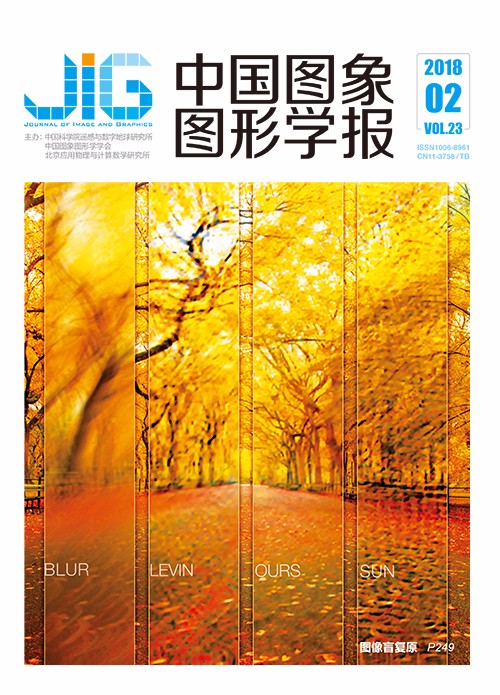
迭代分析相对密度的高光谱异常检测
摘 要
目的 针对复杂高光谱数据在不同地物规模和光谱特征上的差异,致使背景特征难以准确描述,导致异常检测算法检测效果不理想的问题,提出一种基于相对密度分析建立背景模型的高光谱遥感异常检测算法。方法 该算法借助最大相对密度分析的思想,通过统计与待测像元相似像元的数目作为其相对相似性分布密度,在像元光谱特征相似性分布密度的驱动下,自动搜索聚类中心并实现自适应聚类。为了避免不同背景地物受类别规模差异的影响,设计迭代筛选方法不断提取具有相对最大分布密度的类作为背景地物类别。当迭代终止时即可获得关于背景地物的统计模型,最后采用经典的马氏距离实现异常检测。结果 仿真实验采用两组常用的数据HyMap和HYDICE,与经典算法如基于聚类分析的异常检测算法(CBAD)、局部RX算法(LRX)和基于空间边缘特征变化的异常检测算法(2DCAD)等进行比较,并采用受试者工作特性曲线(ROC)和ROC曲线下面积(AUC)作为评价标准对实验结果进行分析。从实验数据中可以看到,本文算法在ROC曲线整体上表现优于其他算法,在HyMap下AUC值比同类算法至少高出5.6%,HYDICE下AUC值比同类算法至少高出13.6%。另外,对于不同数据,本文算法最终表现较为稳定,鲁棒性较好。结论 实验结果表明该算法无需构建分类面以及设定类别数目,在每次迭代中根据数据本身特征自适应地获取当前规模下背景显著性强的像元。另外,本文建立背景模型的方法适用于不同复杂场景下的高光谱数据,可以获得对背景的准确描述,有助于改善高光谱数据异常检测中对异常目标显著性衡量的准确性。
关键词
Hyperspectral anomaly detection algorithm based on iterative analysis with relative density
Li Puhuang, Li Min, Fan Xinnan, Zhang Xuewu(College of Internet of Thing(IOT), Hohai University, Changzhou 213022, China) Abstract
Objective Anomalies typically refer to pixels that evidently reflect different spectral features in a homogeneous background. The regions of the background refer to the pixels that occupy a larger proportion in an image than anomalies. The anomaly detection of hyperspectral remote sensing aims to find the pixels that exhibit distinct spectral features compared with its surrounding pixels. Traditional anomaly detection methods mainly distinguish anomalies by describing the spectral characteristic with a background statistic model, and numerous anomaly detection algorithms are proposed to obtain the uncontaminated statistic model for hyperspectral imagery (HSI). However, the different proportions of ground objects and complex spectrum features of hyperspectral imagery constantly induce a poor representation of the background statistic model. The difference between anomaly and non-anomaly will be weakened, and the final discrimination results will be inaccurate given the existing anomalies in the background statistic model. The spectral character of small background clusters will be covered by large clusters because of the different scales of ground objects and difference in spectral character. The background statistic model cannot be described accurately by extracting all the background pixels simultaneously considering the diversity of the background objects. This paper proposes a novel algorithm for extracting the background model based on the maximum relative density analysis to obtain an accurate background statistic model. An iterative clustering method is applied to address the abovementioned problem and avoid contamination in the background statistic model. Method Iterative screening is applied to extract background objects gradually to obtain small-scale background clusters without interference from the complex spatial distribution and texture feature of ground objects. The relative similarity density for each pixel is defined by the total number of pixels that have similar spectral features under the concept of relative density analysis. Pixels with the largest relative density will be selected as the cluster center under the current scale, driven by the similarity distribution density. One of the background objects will be extracted adaptively on the basis of the cluster center. In each iteration, we only add the cluster with the largest population to the background statistic model. The background pixels will be extracted when the iteration process is terminated, and the background can be modeled by the spectral features of the obtained clusters. The details of the proposed algorithm are as follows. First, the Euclidean distance between pixels is selected as similarity features. Second, the density and central degree of a pixel can be obtained on the basis of the distance from other pixels in the dataset. We select the pixels with high density and central degree as the center of clusters, and then classify the entire hyperspectral data. Finally, classical Mahalanobis distance is used to measure the anomaly salience of the detection results. The pixels with large Mahalanobis distances according to the value of anomaly salience are likely to be anomalies. Simulation experiments were conducted with two sets of hyperspectral imagery, namely, HyMap, and HYDICE; these sets of hyperspectral imagery are commonly used for experiment. The algorithm was compared with classical algorithms, such as CBAD, LRX, and 2DCAD, in the experiments. The detection results were analyzed using ROC and AUC as the evaluation criteria. Result The experimental data indicate that the ROC is generally better in the proposed algorithms than in other algorithms; the AUC tested in two hyperspectral data is higher by at least 5.6% and 13.6% than similar algorithms. The comparison of the computational costs between the proposed and the other algorithms is also presented. The computational cost of the proposed algorithm is not superior, but the comprehensive performance of our method is generally optimal. The proposed and the previous methods differ in two points. The proposed method classifies the pixels according to the degree of difference by the data characteristics, and the result obtained by the proposed method is unaffected by various complex scenes. Furthermore, the proposed method considers the scale of the ground object. Thus, the iterative strategy is applied to focus on the pixels with strongest background feathers in the current iteration and avoid the interference caused by existing different scale backgrounds. The proposed algorithm is stable under two complex scenes. Results show the robustness and effectiveness of the proposed method. Conclusion The pixels with a high degree of anomaly salience are obtained according to the characteristics of the data without constructing the classification surface and setting the number of categories prior. Experimental results also verify that the proposed method improves the effectiveness of the background statistic model and obtains an accurate detection result. The algorithms that can characterize the clutter background accurately will achieve favorable results in anomaly detection. Therefore, the precise estimation of background statistic model is a current research direction. This study provides a novel means of obtaining the model. The novel clustering algorithm combined with the iteration process can extract an efficient uncontaminated model. The proposed method can certainly be improved. The largest population cluster obtained in each iteration step is gathered as the final statistic model. We can also consider clusters independently and analyze the background features under each category. The parameters in this study are determined by experience and experiments. The experiments show that all parameters result in local optimum. Thus, we must develop methods for establishing models for finding global optimal parameters. Furthermore, time consumption requires improvement. The algorithm steps can be further optimized to reduce the time consumption. These steps will be our next research direction.
Keywords
hyperspectral data anomaly detection background statistic model iterative screening largest relative density
|



 中国图象图形学报 │ 京ICP备05080539号-4 │ 本系统由
中国图象图形学报 │ 京ICP备05080539号-4 │ 本系统由